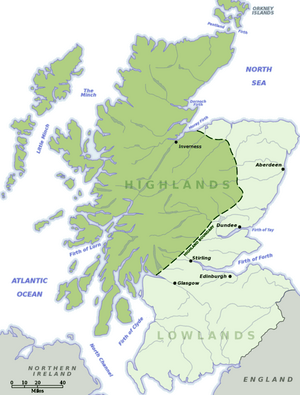Cawdor (Roman fort) facts for kids

Easter Galcantray, sometimes called the Cawdor Roman Fort, is a place near the village of Cawdor in Scotland. It's about 15 miles east of Inverness. People think it might have been a Roman fort, but there isn't much proof from digging up the area (archaeology) to say for sure.
What Was Found There?
In 1984, people saw something interesting at Easter Galcantray from air photos. It looked like it could be a Roman fort.
Archaeologists dug at the site between 1985 and 1990. They found only one small piece of pottery. They thought it was Roman because it looked like another piece found at a Roman fort called Inchtuthil. Other things found there, which people thought were Roman, could have been built at different times in history.
One expert, Jones (in 1986), thought the main parts of the site looked like a Roman military camp. He noticed a straight ditch with a V-shape, which was common for Roman forts. He also found holes in the ground that he thought were for a gate. However, these holes were not evenly spaced, so they might not have been part of the same gate. Jones also saw other holes that he thought were from Roman barracks (buildings where soldiers lived). Again, these holes were not perfectly lined up.
The dating of the site suggests it was used and then left around the late first century AD. This time matches when a Roman governor named Agricola was in charge.
If this site was truly a Roman fort, it would be the most northern Roman fort ever found in Britain! But this is unlikely. The next closest Roman fort, Stracathro, is over 100 miles away. Experts are still not sure if Agricola's army went this far north. Many archaeologists who study the Roman period have not agreed with Jones's ideas about the site.
Why More Research is Needed
Easter Galcantray is close to Inverness. Most serious historians don't believe it was the furthest north the Romans ever went. This is different from what some amateur historians or conspiracy theorists might say.
We know that in the summer of 83 AD, a Roman general named Agricola fought a big battle called the Battle of Mons Graupius. He defeated the Caledonians, who were local tribes led by Calgacus. After winning, Agricola made the Caledonian tribes give him hostages. He also sent his ships to sail around the north coast of Britain. This showed the Romans that Britannia was an island.
Agricola might have marched his army to the northern coast of Britain, possibly reaching the Inverness area where Easter Galcantray is. In 1985, a "small piece of Roman coarse pottery" was found with burnt material in a ditch at the site. But later studies showed this pottery was actually from the Middle Ages, not Roman times.
Also, radiocarbon tests on materials from the site suggested it could have been built in the first century. However, it's hard to be sure because the site was used and then left very quickly. This means there isn't much other evidence. Plus, experts have argued for over 200 years about where the Battle of Mons Graupius actually happened. For example, some like William Roy and Gabriel Jacques Surenne thought it was fought further south near Roman camps like Raedykes or Glenmailen. Others, like Vittorio di Martino, believe the Roman victory happened southwest of Cawdor.
Images for kids
-
Cawdor Roman Fort is located near Inverness. It was once thought to be the northernmost Roman site in Britain, until newer discoveries at Tarradale and Portmahomack.
See also
 In Spanish: Cawdor (fuerte romano) para niños
In Spanish: Cawdor (fuerte romano) para niños



